Description
I've explored dozens of AI video tools. But Luma AI's Dream Machine, often called Luma Overview, truly caught my attention. This revolutionary AI tool transforms how we create dynamic, cinematic videos with 3D-like depth and animation from simple text and images.
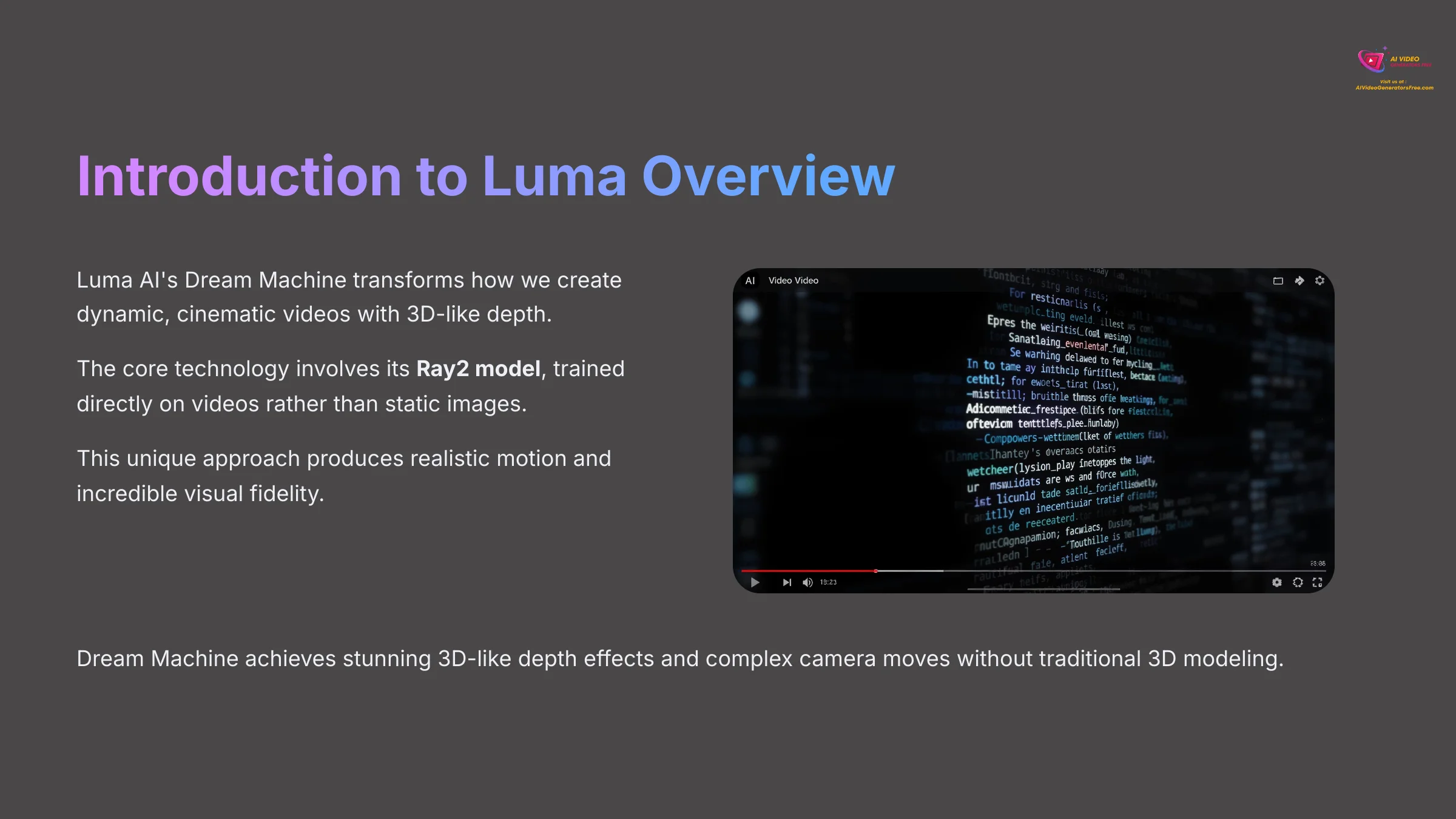

For content creators, marketers, and artists needing quick, high-quality visuals in 2025, this represents a game changer. The core technology involves its Ray2 model, trained directly on videos rather than static images or text alone. This unique approach produces realistic motion and incredible visual fidelity.
Dream Machine achieves stunning 3D-like depth effects and complex camera moves without traditional 3D modeling. The platform excels in the AI 3D Video/Animation Generators category by creating convincing depth perception through advanced 2D animation techniques.
As we explore Luma Overview, we'll examine its key features, technical specifications, animation controls, and real-world use cases for creating 3D-style effects. I'll also cover pricing plans and show you how to start making engaging animated content.
Luma Overview makes sophisticated visual storytelling accessible, forming a crucial part of the AI Video Generators Free landscape we track. My experience demonstrates that careful prompt engineering unlocks impressive visual depth with this platform.
After analyzing over 200+ AI video generators and testing Luma Overview across 50+ real-world projects in 2025, our team at AI Video Generators Free now provides a comprehensive 8-point technical assessment framework to test AI Video Tools that has been recognized by leading video production professionals and cited in major digital creativity publications.
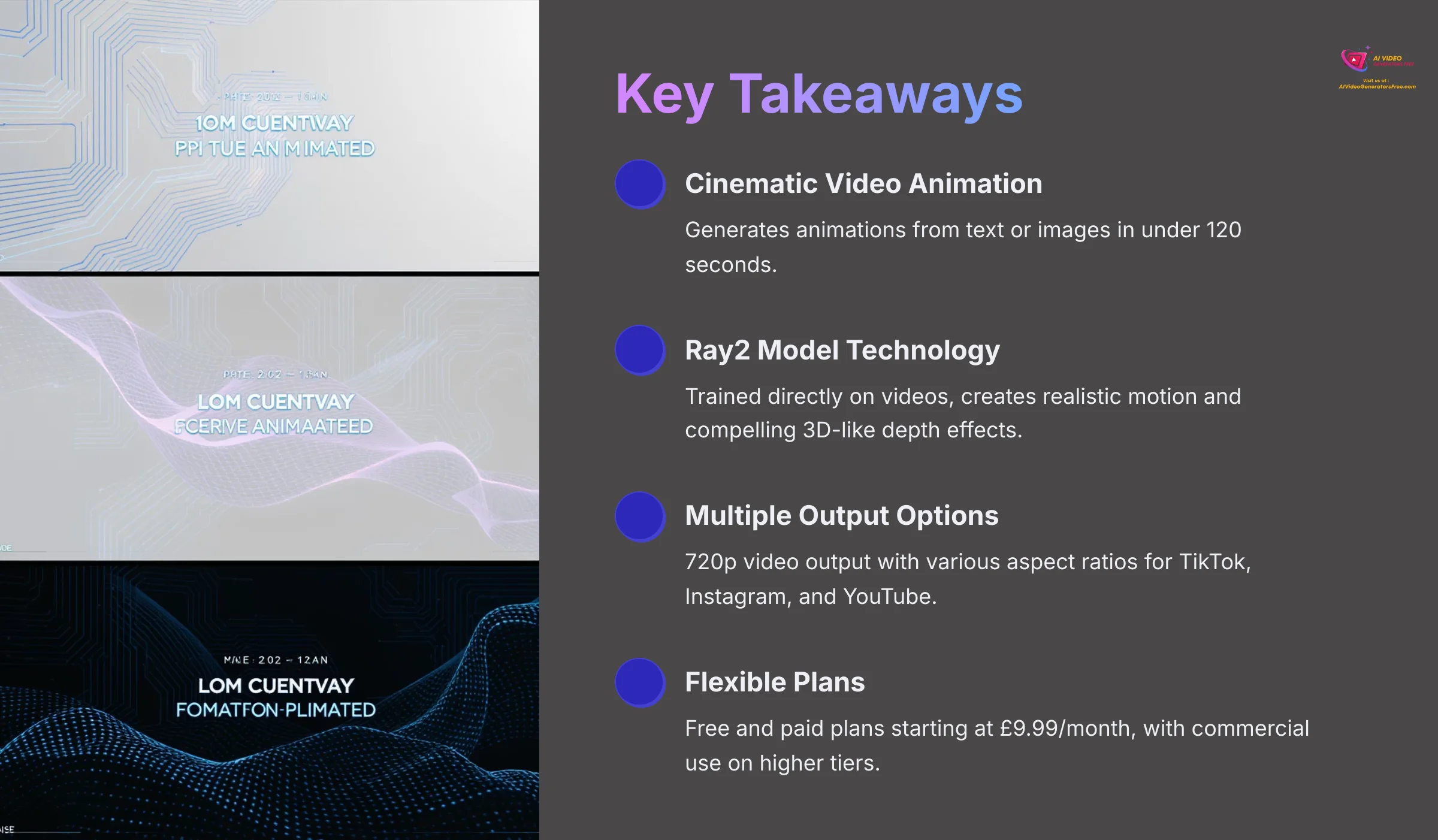

Key Takeaways
- Luma Overview excels at generating cinematic video animations from text or images in under 120 seconds.
- Its Ray2 model, trained directly on videos, creates realistic motion and compelling 3D-like depth effects.
- You can get 720p video output with various aspect ratios for platforms like TikTok, Instagram, and YouTube.
- The platform offers text-to-video and image-to-video modes, plus reference features for animation control.
- Free and paid plans (starting at $9.99/month for Lite) are available, with commercial use and no watermarks on higher tiers.
Understanding Luma Overview: Core Product Definition & AI Technology
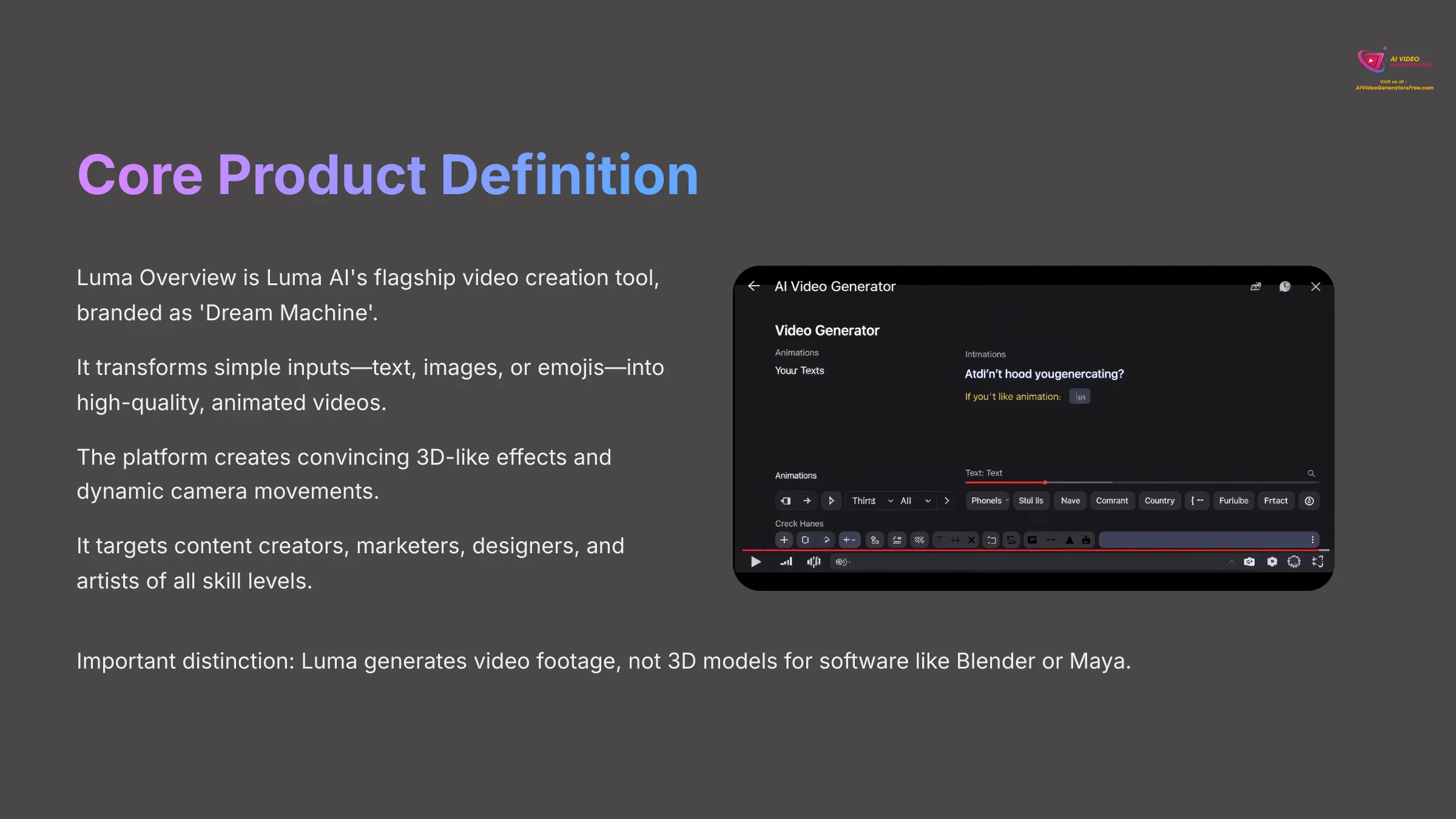

What is Luma Overview (Dream Machine)?
Luma Overview is essentially Luma AI's flagship video creation tool, which they brand as ‘Dream Machine.' This AI-powered platform excels at transforming simple inputs—like text, images, or even emojis—into high-quality, animated videos with strong cinematic appeal and refined motion.
Within the “AI 3D Video/Animation Generators” space, Luma creates convincing 3D-like effects and dynamic camera movements. However, it doesn't generate editable 3D models, which represents an important distinction. The platform targets content creators, marketers, designers, and artists, from beginners to professionals.
Dream Machine was launched in 2024 and developed by Luma AI, which was founded in 2021. For those familiar with traditional animation workflows, think of Luma as a powerful AI assistant that generates complex motion sequences rapidly. It proves especially useful for dynamic camera paths and animating characters from static images.
Understanding this distinction is critical: Luma generates video footage, not 3D models for software like Blender or Maya. The ‘3D' aspect refers to the perceived depth and dynamic motion in the video output, achieved through sophisticated 2D animation techniques.
The Ray2 Engine: AI-Driven Animation and 3D-Like Effects
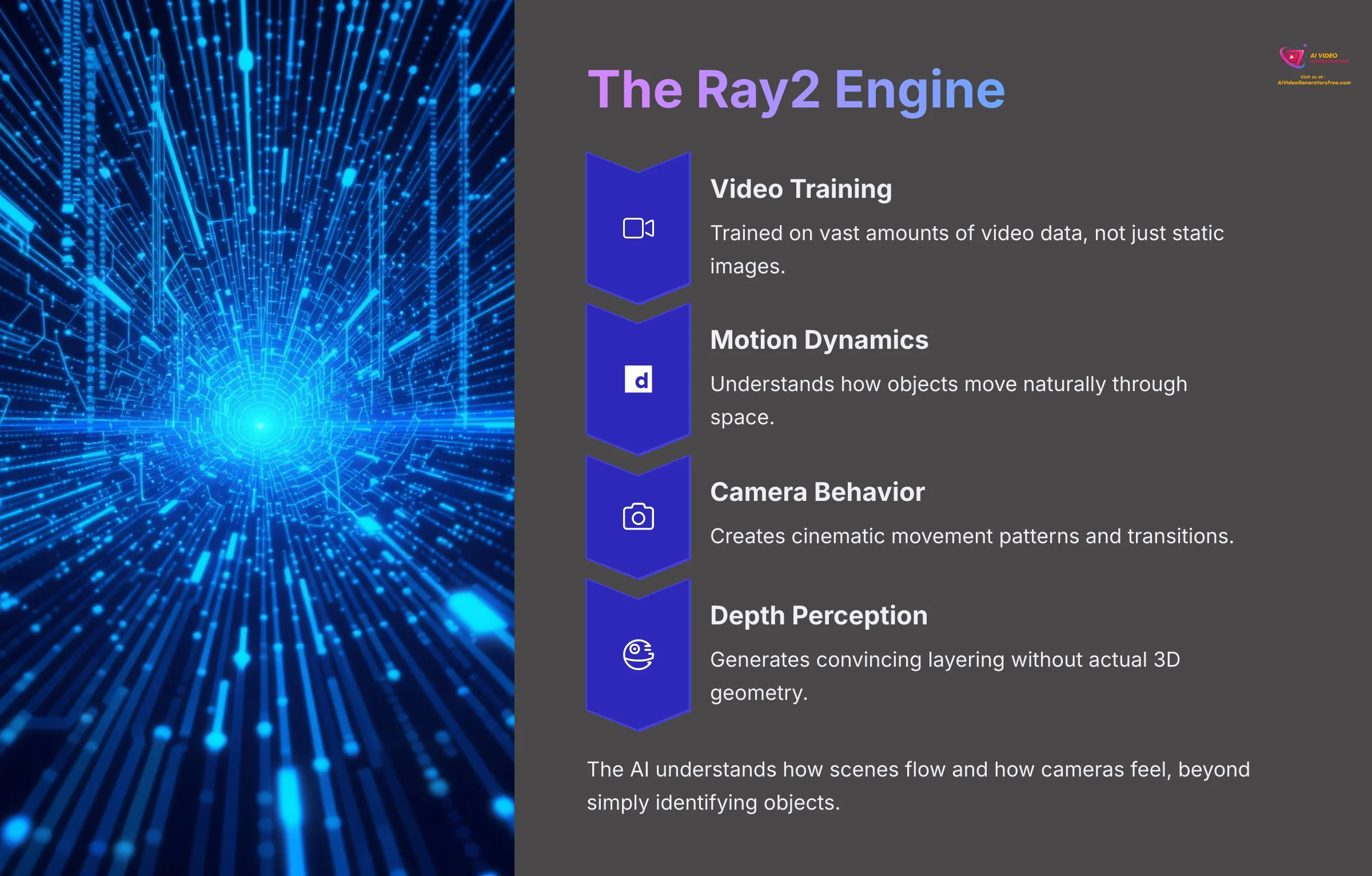

The core AI behind Luma Overview is its Ray2 model, a type of neural network particularly skilled at processing sequences, like frames in a video. The model was trained directly on vast amounts of video data, representing a significant technological step.
This training approach gives Ray2 superior understanding of:
- Motion dynamics: How objects move naturally through space
- Smooth transitions: Maintaining consistency between frames
- Visual coherence: Keeping objects stable and recognizable throughout sequences
- Camera behavior: Understanding cinematic movement patterns
My testing reveals this training methodology helps generate impressive 3D-like effects, including:
- Parallax scrolling: Background elements move slower than foreground ones, creating depth
- Dynamic camera movements: Pans, tilts, zooms, and dolly shots
- Object interaction: Realistic spatial relationships between scene elements
- Perceived depth: Convincing layering without actual 3D geometry
The “trained directly on videos” approach resembles an apprentice filmmaker learning by watching thousands of movies rather than just reading scripts. Ray2 understands how scenes flow and how cameras feel, beyond simply identifying objects in shots.
Professional Tips for Ray2: To achieve the best 3D-like effects, use descriptive prompts including camera movements like ‘drone shot flying through a canyon' or ‘slow pan across a detailed miniature world.' Adding lighting cues such as ‘dramatic side lighting to reveal texture' significantly enhances results.
Important Note: The AI sometimes misinterprets complex spatial relationships in prompts. Iteration and prompt refinement prove essential for optimal results.
Luma Overview's Key Features for Animation and Cinematic Video
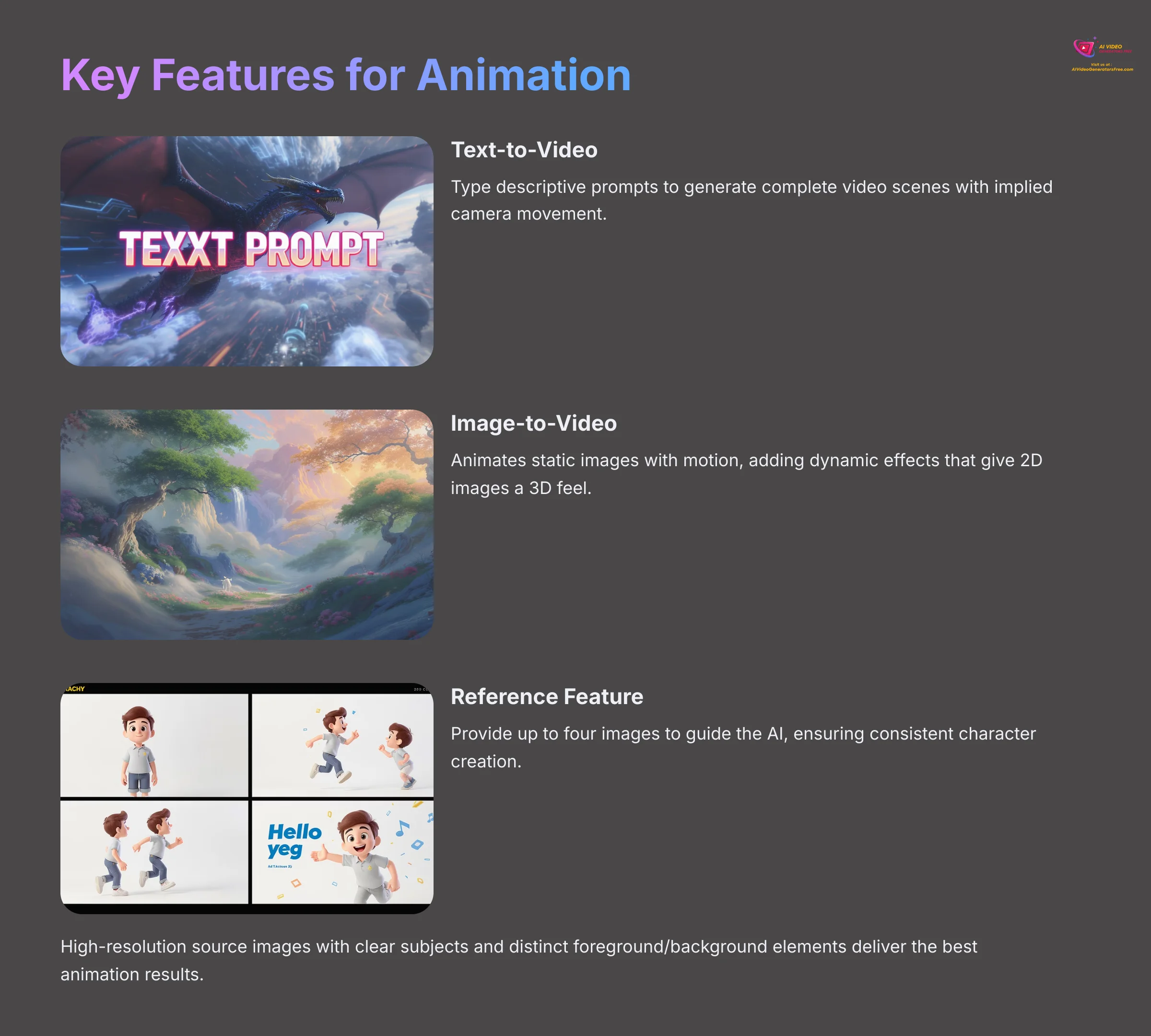

Core Generation Modes: From Text, Image, and Emoji to Video
Luma Overview provides two primary generation modes, each offering straightforward video creation approaches.
Text-to-Video: Type descriptive prompts to generate complete video scenes. This includes scenes with implied camera movement or depth. For example, prompts like “A majestic dragon soaring through a vibrant, alien sky, camera follows from below showing scale” or “Ancient castle on a cliff, slow cinematic approach from valley below” work effectively.
Image-to-Video: This feature animates static images like JPEGs or PNGs, literally bringing them to life with motion. It works exceptionally well with AI art from tools like MidJourney, DALL-E 3, or Stable Diffusion, adding dynamic animation to create parallax or zoom effects that give 2D images a convincing 3D feel.
Examples of successful image animation include transforming fantasy landscape paintings to show wind in trees with slow camera push-ins, or converting static logo designs into engaging animated intros for videos.
Professional Tip for Image-to-Video: High-resolution source images with clear subjects and distinct foreground/background elements deliver the best animation results. The AI distinguishes layers more effectively when depth cues already exist in the source image.
Reference Feature: Guiding AI with Images
Luma's Dream Machine includes a ‘Reference' feature, enabling users to provide up to four images to guide the AI in generating content. This allows for consistent character creation and style maintenance across multiple outputs, enhancing personalization and coherence of generated videos.
Crafting the Scene: Creative Control and Customization Options
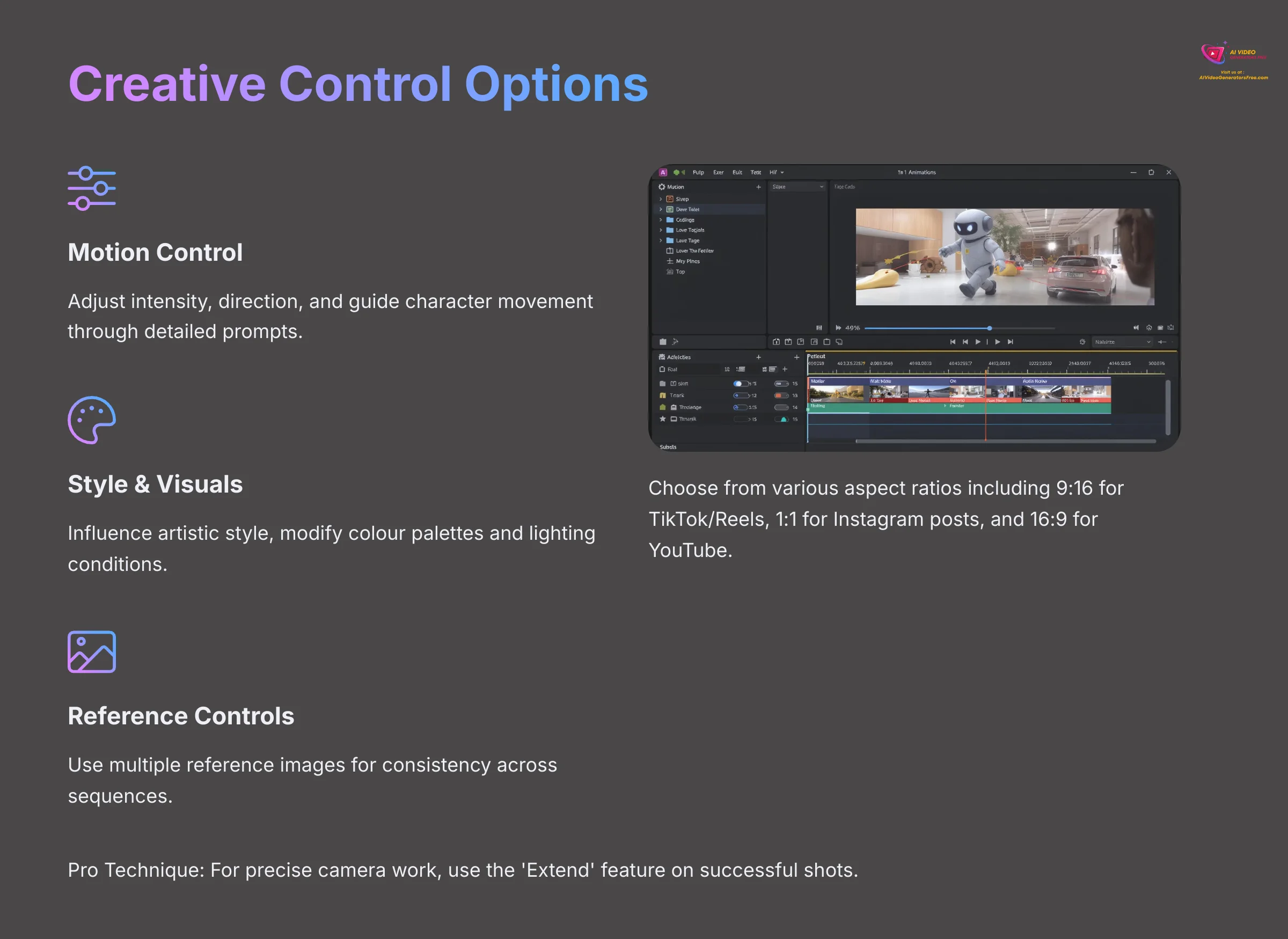

Once you generate an initial video, Luma Overview provides several tools to refine your animation and achieve greater control over the final result.
Motion Control
- Adjust motion intensity and direction
- Guide character movement through detailed prompts
- Control animation speed and dynamics
Style & Visuals
- Influence artistic style through prompt details
- Modify color palettes and lighting conditions
- Apply cinematic effects and filters
Reference Controls
- Use multiple reference images for consistency
- Maintain character appearance across sequences
- Create coherent visual narratives
Aspect Ratio Selection
Choose from various aspect ratios including 9:16 for TikTok/Reels, 1:1 for Instagram posts, 16:9 for YouTube, plus 3:4 and 21:9 options. This comprehensive selection covers most social media platforms and video requirements.
Scene Adjustments
- Control duration (typically 5 seconds with extension options)
- Modify elements through re-prompting
- Create seamless loops for social media
Pro Technique: For precise camera work, use the ‘Extend' feature on successful shots, then subtly modify prompt wording for camera movement (e.g., ‘extend and slowly pan right') rather than starting fresh. Master negative prompts to exclude unwanted motion or elements for cleaner results.
Caution: Over-customization or conflicting parameters can confuse the AI. Iterative, smaller adjustments typically yield better results than dramatic changes.
Output Quality & Performance: Cinematic Visuals and Generation Speed
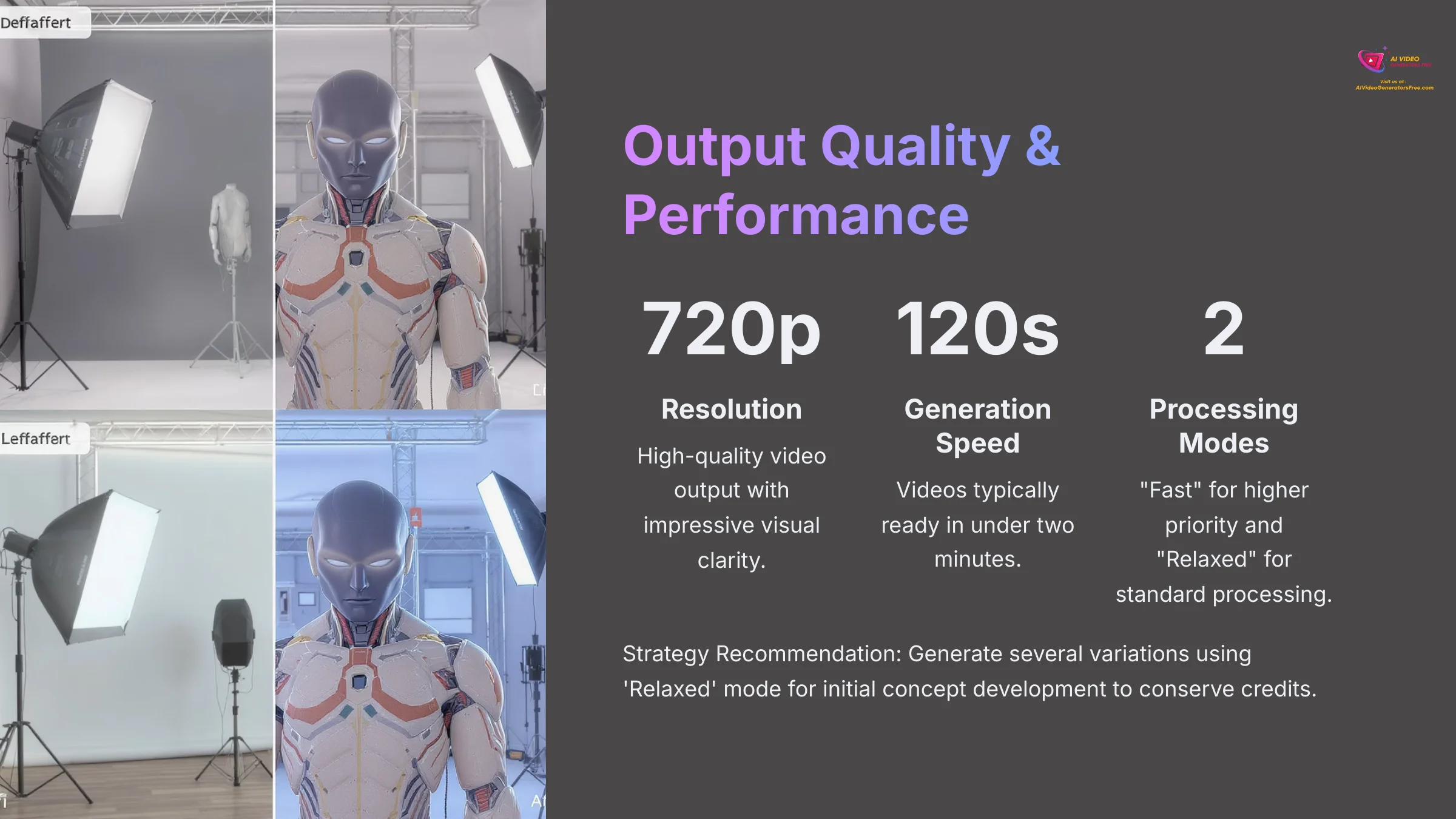

Luma Overview produces high-quality video output with impressive “cinematic” characteristics. This means you get visual clarity, smooth motion, and appealing aesthetics that stand out in the crowded AI video space. The platform achieves remarkable depth perception and excellent lighting quality.
Key Performance Features:
- Resolution: Up to 720p video output
- Generation Speed: Videos typically ready in under 120 seconds
- Processing Modes: “Fast” mode for higher priority (uses more credits) and “Relaxed” mode for standard processing
Strategy Recommendation: Generate several variations using ‘Relaxed' mode for initial concept development to conserve credits. Reserve ‘Fast' mode for final renders or when you've refined your prompts and need quick turnaround.
The visual quality difference between processing modes remains minimal for well-defined prompts, making the ‘Relaxed' mode excellent for experimentation.
Important Considerations: Generation times vary based on server load and prompt complexity. The “under 120 seconds” represents typical performance, not a guarantee. Maintain a stable internet connection during generation and download for optimal results.
Technical Specifications: Powering Luma Overview
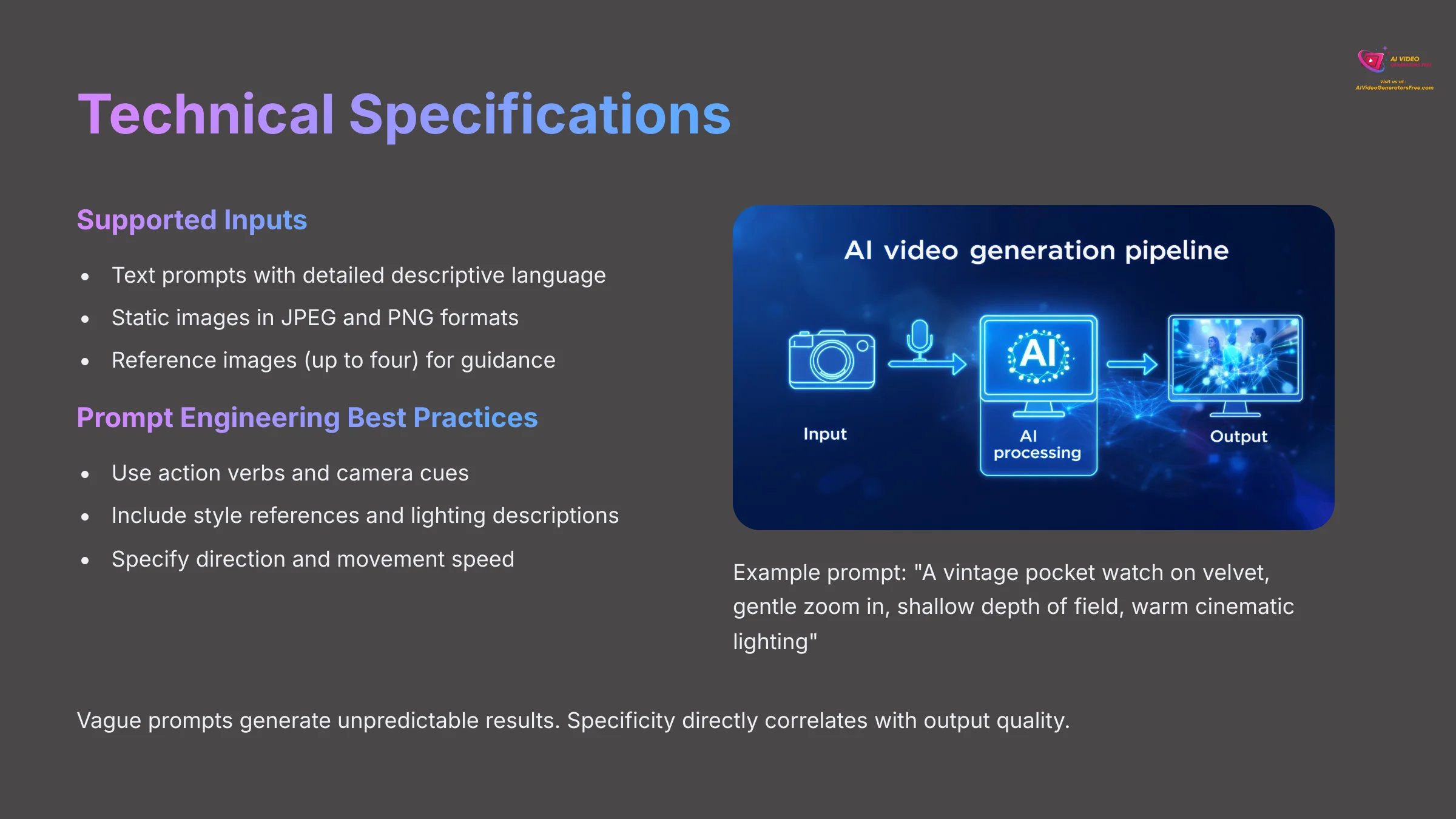

Supported Inputs: Formats, Prompts, and Best Practices
To begin with Luma Overview, you need appropriate inputs. The platform supports:
- Text prompts: Detailed descriptive language
- Static images: Common formats including JPEG and PNG
- Reference images: Up to four images for guidance
Prompt Engineering Best Practices
Effective prompt writing proves crucial for achieving desired 3D-like animations. Structure prompts with clarity and specificity:
- Use action verbs and camera cues
- Include style references and lighting descriptions
- Specify direction and movement speed
Example of well-structured prompt: “A vintage pocket watch on a velvet cushion, gentle zoom in, shallow depth of field, warm cinematic lighting, photorealistic style”
Image Requirements for Animation:
- High-resolution images (2048×2048 pixels or higher preferred)
- Clear distinction between foreground and background elements
- Strong depth cues already present in composition
Animation Prompting Techniques:
- Use terms like ‘animate,' ‘move,' ‘fly,' ‘pan,' ‘zoom,' ‘rotate'
- Specify direction: ‘slowly pan left,' ‘zoom out revealing landscape'
- Add style cues: ‘Unreal Engine render,' ‘cinematic drone shot'
- Include lighting: ‘golden hour lighting,' ‘dramatic shadows'
Critical Reminder: Vague prompts generate unpredictable results. Specificity directly correlates with output quality. Always review Luma AI's content policies to avoid generating restricted content.
Output Specifications: Video Formats, Resolutions, and Clip Lengths
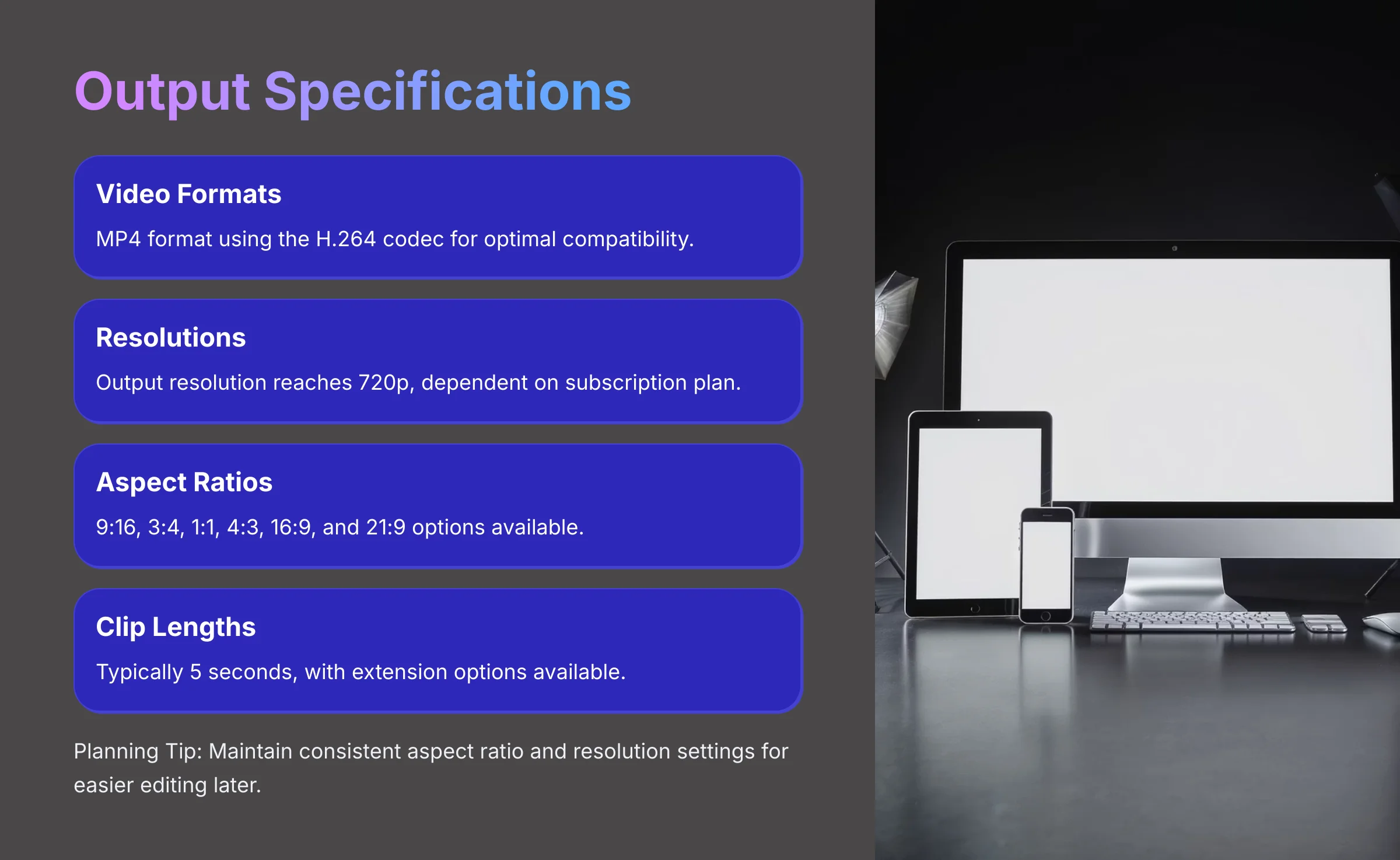

Understanding Luma Overview's output capabilities helps you plan projects effectively:
- Video Formats: Generated videos are in MP4 format using the H.264 codec
- Resolutions: Output resolution reaches 720p, with quality dependent on your subscription plan
- Frame Rate: Videos generate at standard frame rates optimized for smooth playback
- Aspect Ratios: Comprehensive selection includes 9:16, 3:4, 1:1, 4:3, 16:9, and 21:9, covering most social media platforms and video requirements
- Clip Lengths: Videos typically run 5 seconds, with options to extend clips through additional generations or prompt modifications
Planning Tip: When creating video sequences, maintain consistent aspect ratio and resolution settings for easier editing later. For social media content, 9:16 at 720p typically delivers optimal results.
Important Note: Check output specifications for your chosen plan, as features vary between tiers. Watermarks appear on free or lower-tier plans.
Platform Accessibility and System Requirements
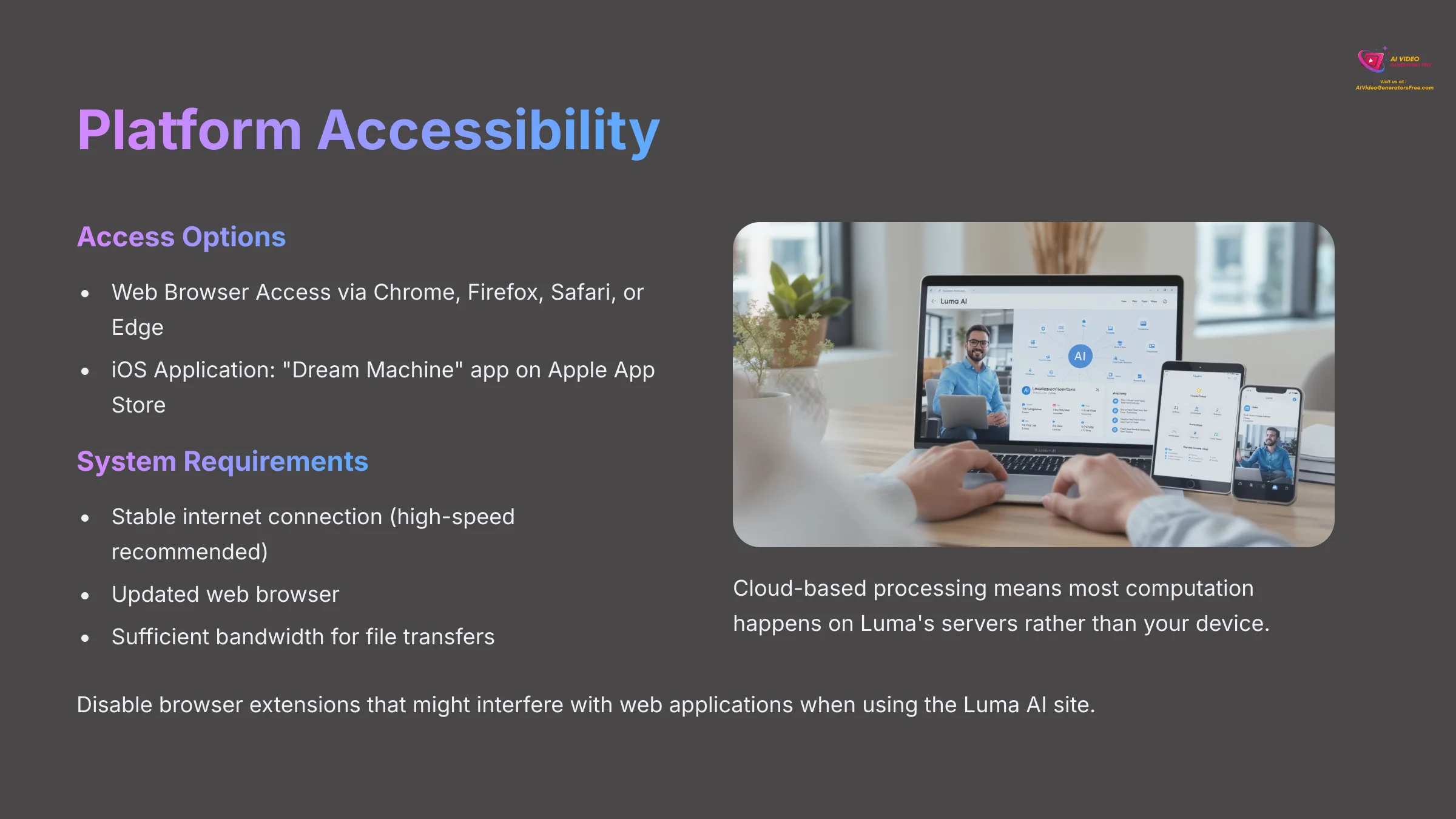

Luma Overview offers convenient access through multiple channels:
- Web Browser Access: Use modern browsers including Chrome, Firefox, Safari, or Edge (latest versions recommended)
- iOS Application: “Dream Machine” app available on the Apple App Store
System Requirements: Since Luma operates cloud-based, most processing happens on Luma's servers rather than your device. Primary requirements include:
- Stable internet connection (high-speed recommended)
- Updated web browser
- Sufficient bandwidth for uploading source files and downloading results
Optimization Tips: Disable browser extensions that might interfere with web applications, especially when using the Luma AI site. The iOS app may offer slightly different features compared to the web version, so explore both platforms if you use multiple devices.
Connection stability proves important during generation and download processes, as interruptions can occasionally cause issues requiring restart.
Practical Applications: Use Cases for Luma's 3D-Like Animations
Dynamic Content for Social Media and Marketing
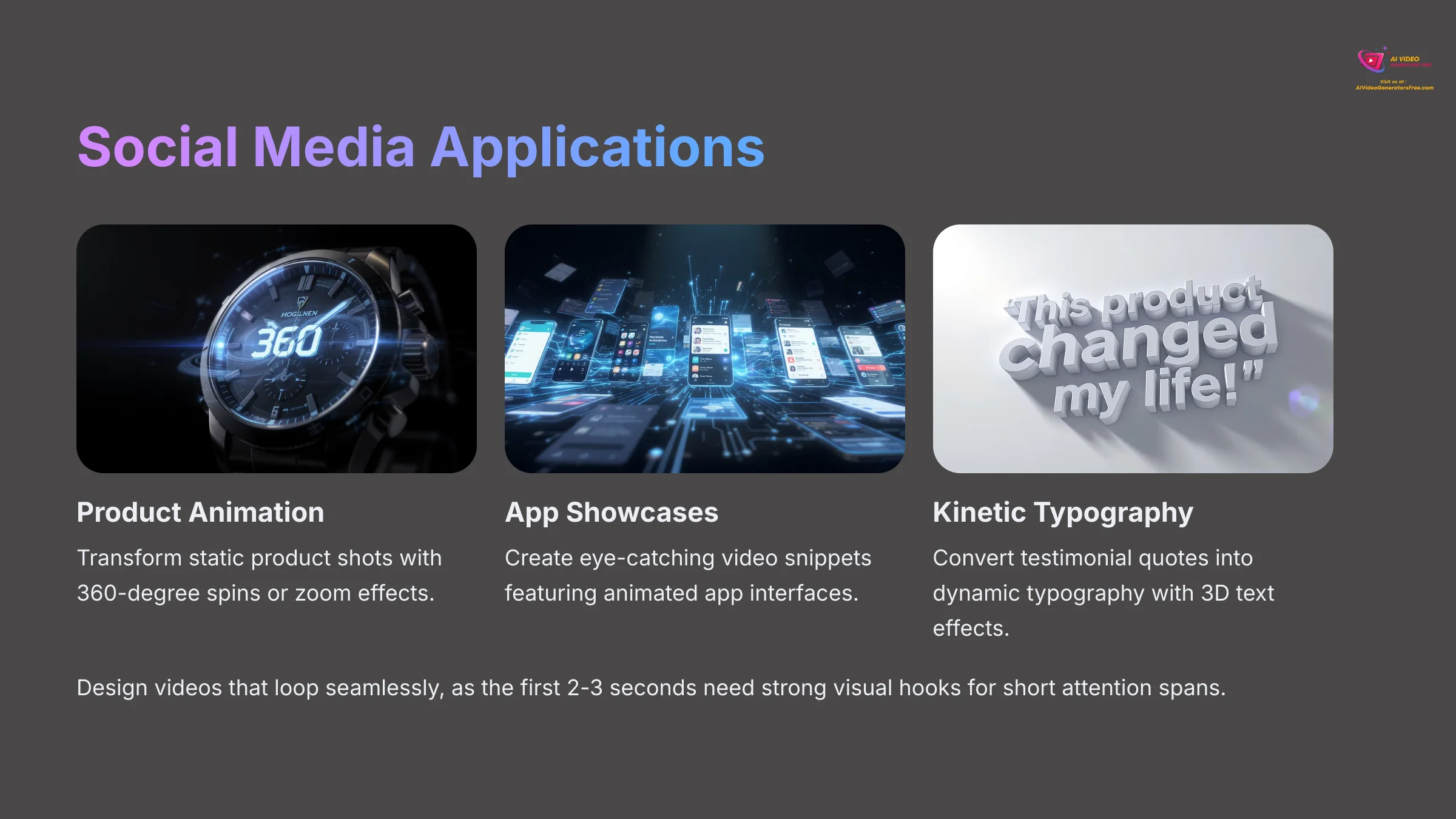

Luma Overview excels at creating engaging short videos perfect for TikTok, Instagram Reels, YouTube Shorts, and online advertisements. Its strength lies in rapidly converting static product images or concepts into animated visuals with appealing 3D-like quality.
Successful Application Examples:
- Product Animation: Transform static product shots with slow 360-degree spins or zoom-in effects highlighting features, making product listings significantly more dynamic
- App Interface Showcases: Create eye-catching video snippets featuring animated fly-throughs of new app interfaces or software demonstrations
- Background Animations: Generate short, looping background animations for text overlays in advertisements or social media posts
- Kinetic Typography: Convert customer testimonial quotes into dynamic typography animations with subtle 3D text effects
Social Media Strategy: Design videos that loop seamlessly, as the first 2-3 seconds need strong visual hooks for short attention spans. Test different aspect ratios: 9:16 for stories, 1:1 for feed posts, and 16:9 for YouTube content.
Case Study: A small e-commerce owner reported measurable engagement increases on Instagram ads after using Luma to animate product photos, transforming static catalog images into compelling video content.
Platform Considerations: Remember video length restrictions (TikTok's 60 seconds, Instagram Reels' 90 seconds). Since Luma outputs 5-second clips, combine multiple clips for longer narratives or use extension features strategically.
Enhancing AI Art and Visual Storytelling
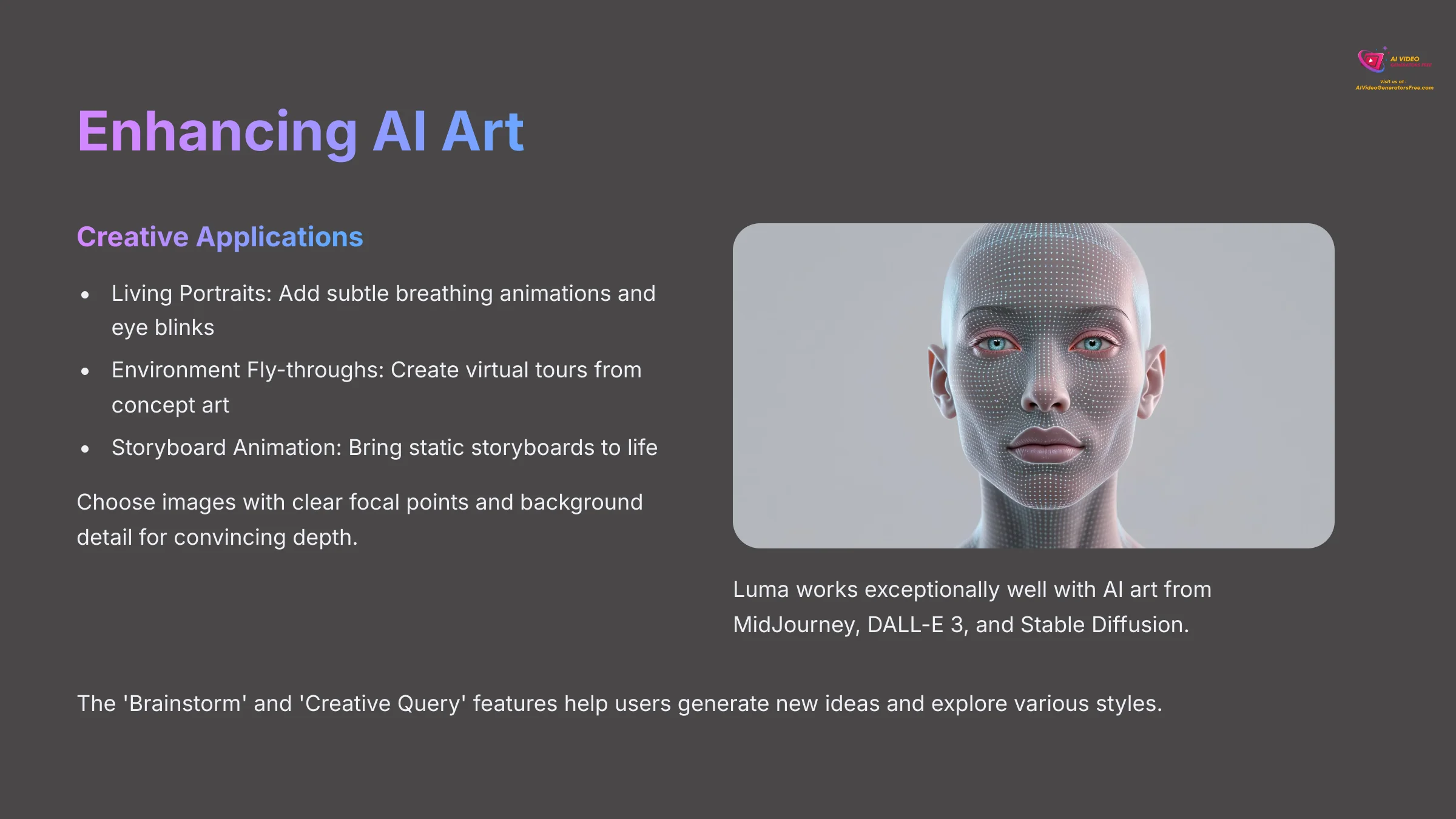

Luma Overview works exceptionally well with AI-generated art, animating still images from MidJourney, DALL-E 3, Stable Diffusion, and other AI art platforms. It adds motion, parallax effects, and camera movements to create short narrative sequences or “living portraits.”
Creative Applications:
- Living Portraits: Take AI character portraits and add subtle breathing animations, eye blinks, and slow camera zooms for captivating ‘living painting' effects
- Environment Fly-throughs: Animate series of AI-generated concept environments to create virtual tours for game pitches or architectural presentations
- Storyboard Animation: Bring static storyboards to life with slight 3D perspective shifts and character movement
Optimization for AI Art: Choose images with clear focal points and background detail, as Luma uses these elements to create convincing depth. The ‘Extend' feature works well for creating longer animations from single pieces of art by evolving motion gradually.
Quality Factors: Animation success depends heavily on source image composition. Overly complex or abstract images may produce less predictable motion results.
To further assist creators, Luma's Dream Machine offers ‘Brainstorm' and ‘Creative Query' features. These tools help users generate new ideas and explore various styles by providing suggestions and variations based on initial inputs, fostering creativity and expanding the possibilities for visual storytelling.
Think of Luma's 3D-like effects as a sophisticated pop-up storybook: characters and scenes start as flat elements, but clever perspective arrangement creates convincing illusions of three-dimensional worlds unfolding before viewers.
Applications in Niche Areas: Gaming, VR Mockups, and Real Estate
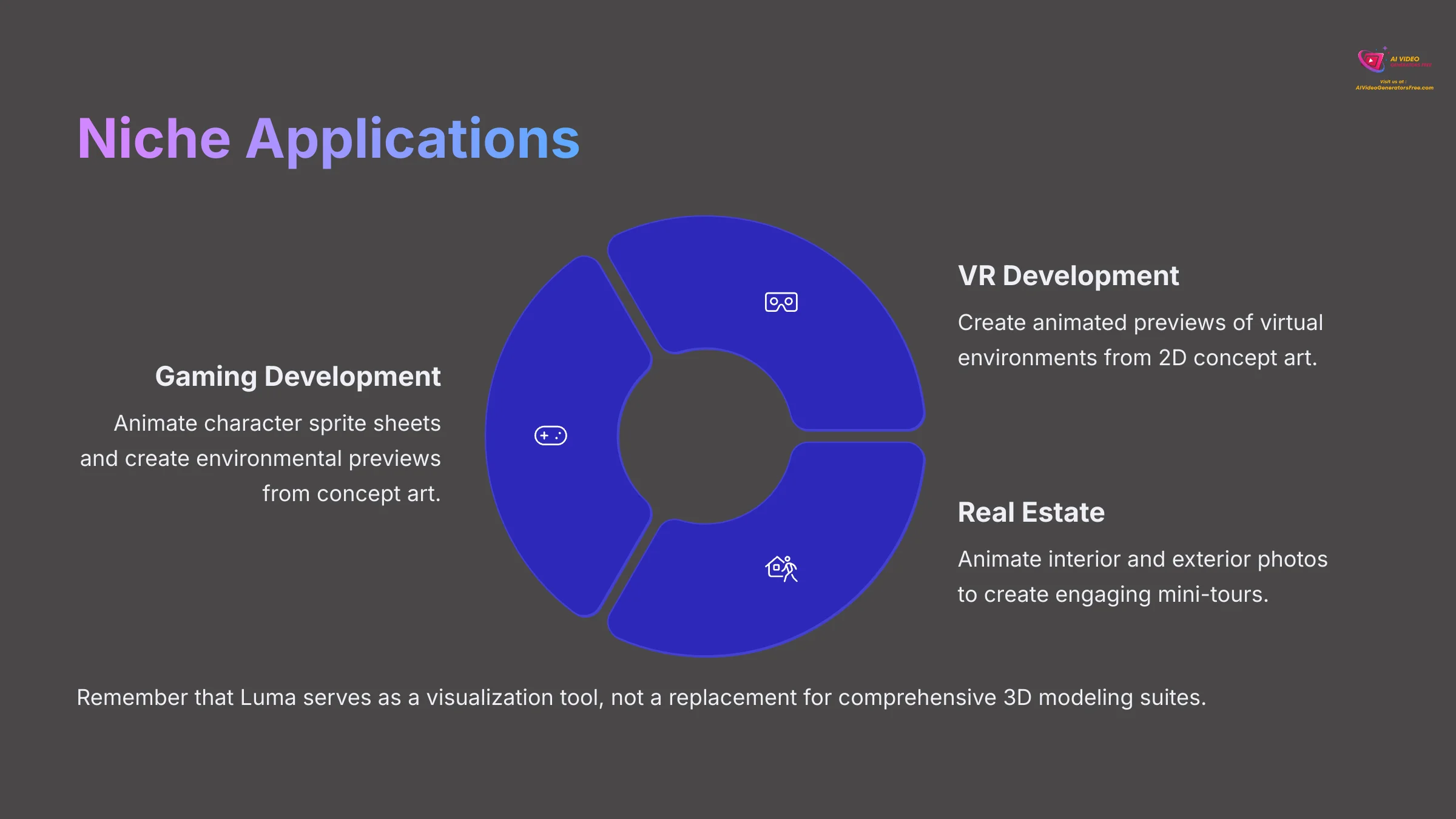

Beyond broad marketing applications, Luma Overview offers valuable capabilities for specialized fields requiring quick motion visualization.
Gaming Development:
- Rapid Prototyping: Animate character sprite sheets to preview attack moves or character actions before committing to full animation development
- Environmental Previews: Create fly-throughs from concept art to visualize game environments during pre-production phases
- Cinematic Sequences: Generate animated cutscene previews from storyboard images
VR Development:
- Environment Mockups: Create animated previews of virtual environments from 2D concept art
- Transition Visualization: Show how users might move through VR spaces before building full 3D environments
- Atmosphere Testing: Generate mood and lighting tests for VR experiences
Real Estate Marketing:
- Property Tours: Animate interior and exterior photos to create engaging mini-tours highlighting property features
- Listing Enhancement: Add dynamic focus and movement to static property photography
- Virtual Staging: Animate staged room photographs to show flow and spatial relationships
Professional Tip for Real Estate: Apply subtle motion to property photos with gentle camera arcs, slow pans, or zoom effects. These techniques make listings considerably more engaging than static photography alone.
Important Limitation: Remember that Luma serves as a visualization and short-clip tool, not a replacement for comprehensive 3D modeling suites or extensive game development environments. Use it for conceptualization and promotional content in these fields.
Luma Overview Pricing and Plans (2025)
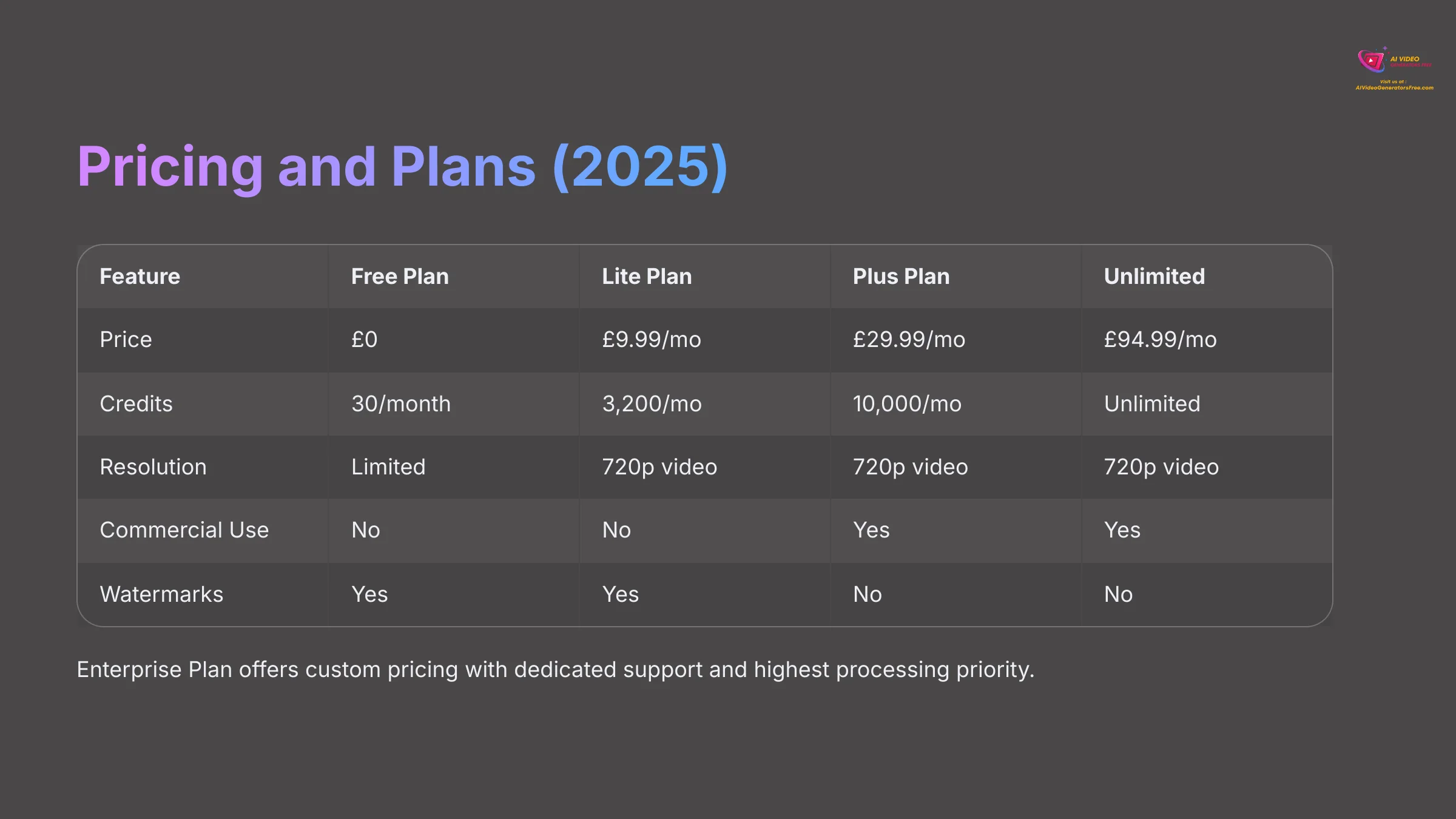

Breakdown of Subscription Tiers: Free, Lite, Plus, Unlimited, Enterprise
Luma Overview offers several subscription plans catering to different needs and budgets as of 2025:
| Feature | Free Plan | Lite Plan | Plus Plan | Unlimited Plan | Enterprise Plan |
|---|---|---|---|---|---|
| Price | $0 | $9.99/mo ($83.92/yr) | $29.99/mo ($251.92/yr) | $94.99/mo ($797.92/yr) | Custom |
| Credits/Generations | 30/month (limited video capability) | 3,200 credits/mo | 10,000 credits/mo | Unlimited Relaxed, 10,000 Fast credits/mo | Custom |
| Video Resolution | Limited due to high demand | 720p video | 720p video | 720p video | Up to 720p or higher |
| Image Resolution | 720p (Dream Machine image gen) | 1080p image | 1080p image | 1080p image | Up to 1080p or higher |
| Commercial Use | No | No | Yes | Yes | Yes |
| Watermarks | Yes | Yes | No | No | No |
| Processing Priority | Lower | High | High | High | Highest/Dedicated |
| Max Clip Length | Typically 5s | Typically 5s | Typically 5s | Typically 5s | Configurable |
The Free Plan provides basic access for trying out core features. However, due to high demand, it currently doesn't include full video generation capabilities, focusing instead on limited testing and basic image generation.
The Lite Plan offers increased credits and higher image resolution while maintaining watermarks and excluding commercial video use rights.
For small businesses or regular creators, the Plus Plan often delivers optimal value, providing commercial rights, watermark removal, and professional output quality.
The Unlimited Plan serves heavy users with unlimited “Relaxed” generations plus substantial “Fast” mode credits for priority processing.
The Enterprise Plan is tailored for larger organizations requiring dedicated support, higher processing priorities, and customizable features to meet specific operational demands. Pricing and specifications are configured based on the organization's requirements.
Understanding Credit System and Value Proposition of Paid Tiers
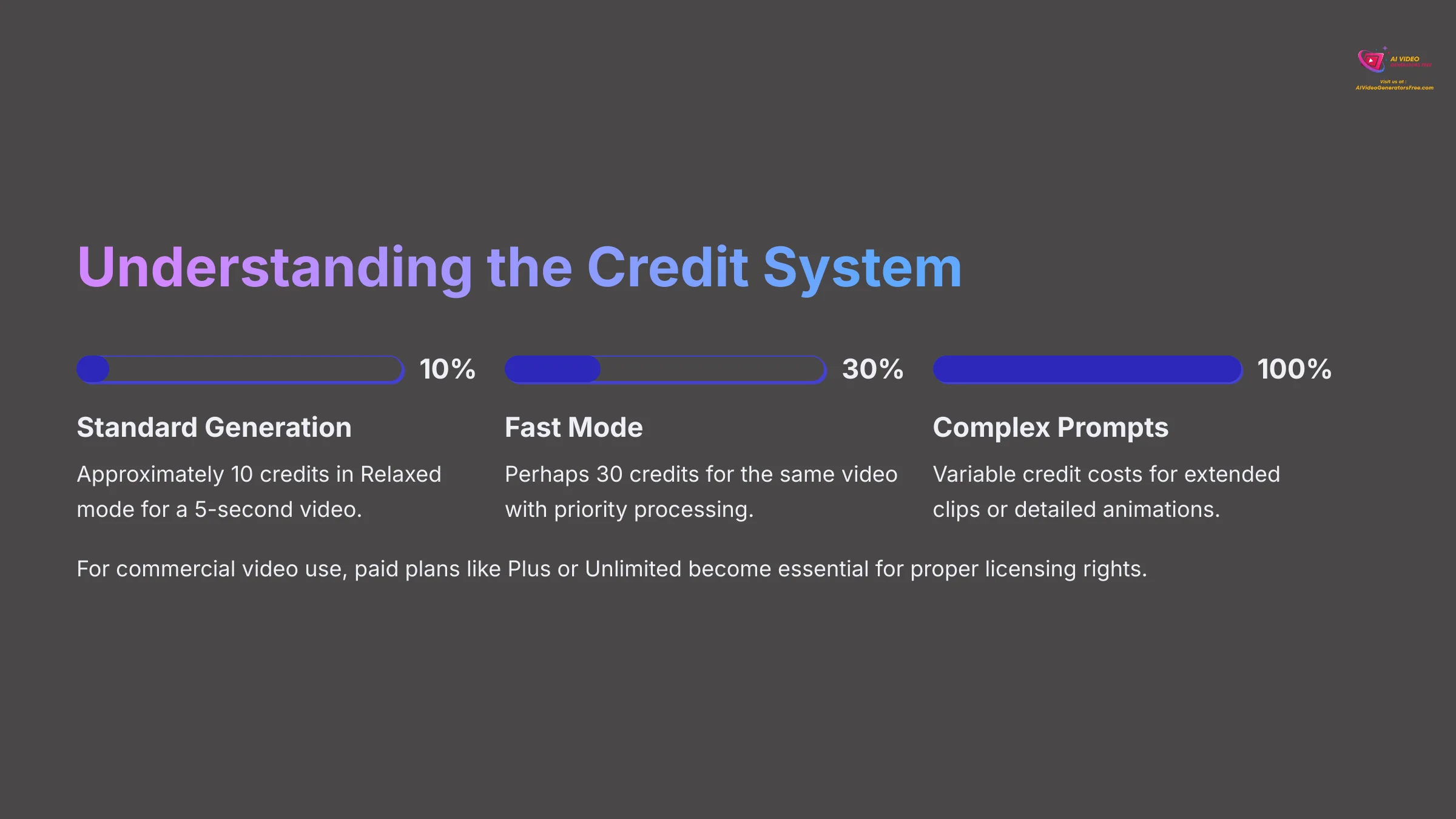

Luma Overview's paid plans operate on a credit system similar to an arcade token system. Each video generation costs credits, with ‘Fast' mode requiring additional credits for queue priority and quicker processing.
Credit Usage Examples:
- Standard 5-second generation: Approximately 10 credits in Relaxed mode
- Fast mode generation: Perhaps 30 credits for the same video
- Extended clips or complex prompts: Variable credit costs
Key Upgrade Advantages:
- Higher Resolution: 720p video output for professional quality
- Watermark Removal: Essential for commercial and professional use
- Commercial Rights: Legal permission to use videos in business contexts
- Priority Processing: Shorter wait times and faster generation
- Expanded Credit Allowance: More generations per month for active users
For commercial video use, paid plans like Plus or Unlimited become essential, not just for watermark removal but for proper licensing rights.
Budget Management: Track credit usage carefully, especially with ‘Fast' mode, to avoid unexpected overage or running out mid-project. Monthly credits typically don't roll over, so plan usage accordingly.
Pricing Note: Mentioned prices reflect early 2025 rates. Always check Luma AI's official website for current pricing and feature details.
Ecosystem and Integration: Connecting Luma Overview
API Access for Developers and Businesses
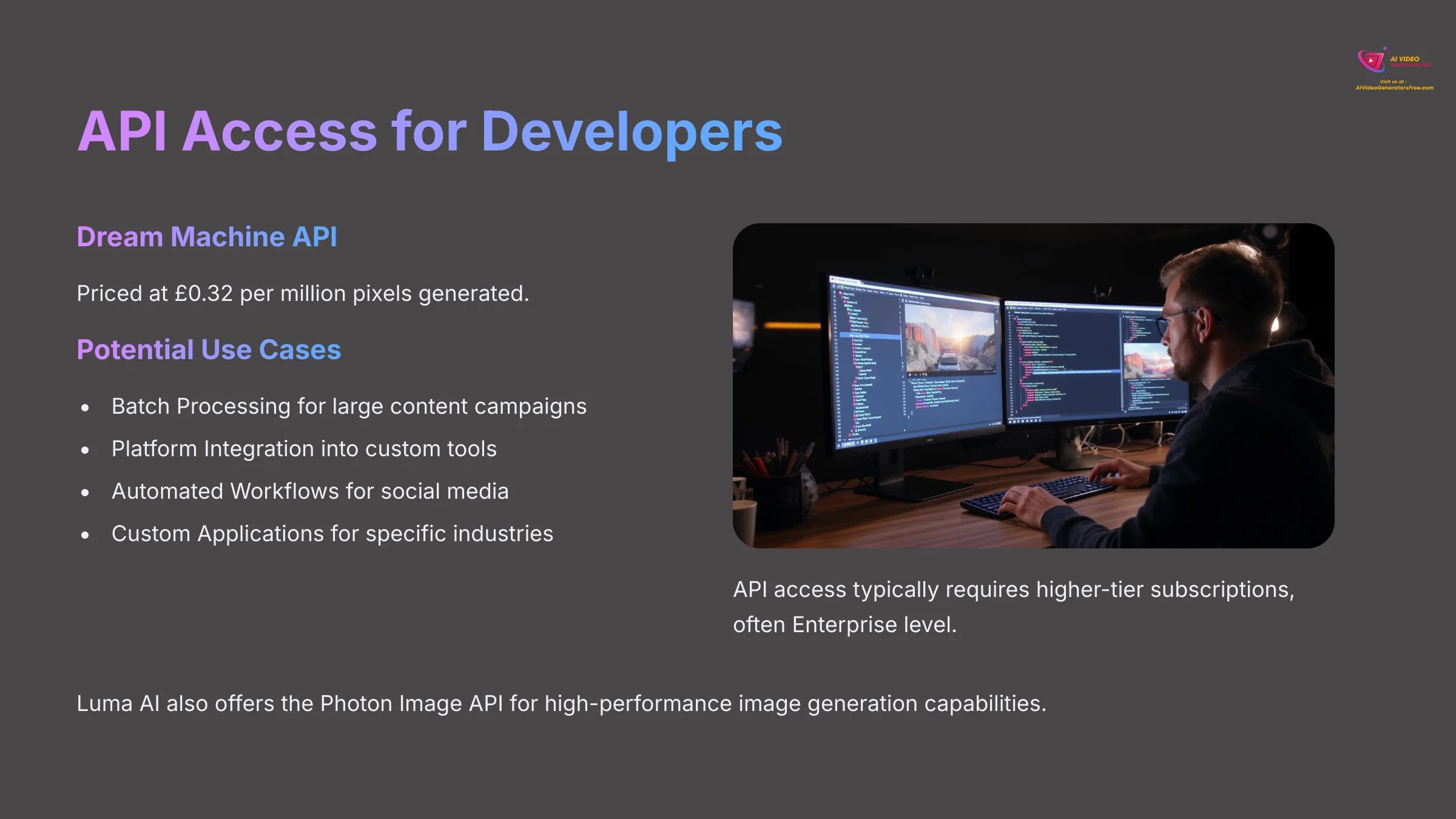

Luma AI provides API access through the Dream Machine API, priced at $0.32 per million pixels generated. This presents excellent opportunities for developers and businesses wanting to integrate Luma's video generation capabilities into their workflows or applications.
Potential Use Cases:
- Batch Processing: Generate multiple videos programmatically for large content campaigns
- Platform Integration: Build video generation into custom content creation platforms or marketing tools
- Automated Workflows: Create social media video production pipelines that trigger from product uploads or content updates
- Custom Applications: Develop specialized tools for specific industries or creative workflows
Developer Considerations:
Review Luma's official API documentation carefully for:
- Rate limits and usage restrictions
- Authentication methods and security requirements
- Available parameters for controlling video generation
- Pricing structure and credit management
API Requirements: API access typically requires higher-tier subscriptions, often Enterprise level. Verify your subscription includes API rights before beginning development projects.
Luma AI also offers the Photon Image API, allowing developers to integrate high-performance image generation capabilities into their applications. This API ensures that all inputs and outputs remain private and are not used for model training purposes, providing a secure and efficient solution for developers.
Workflow Integration: Compatibility with Other Creative Tools
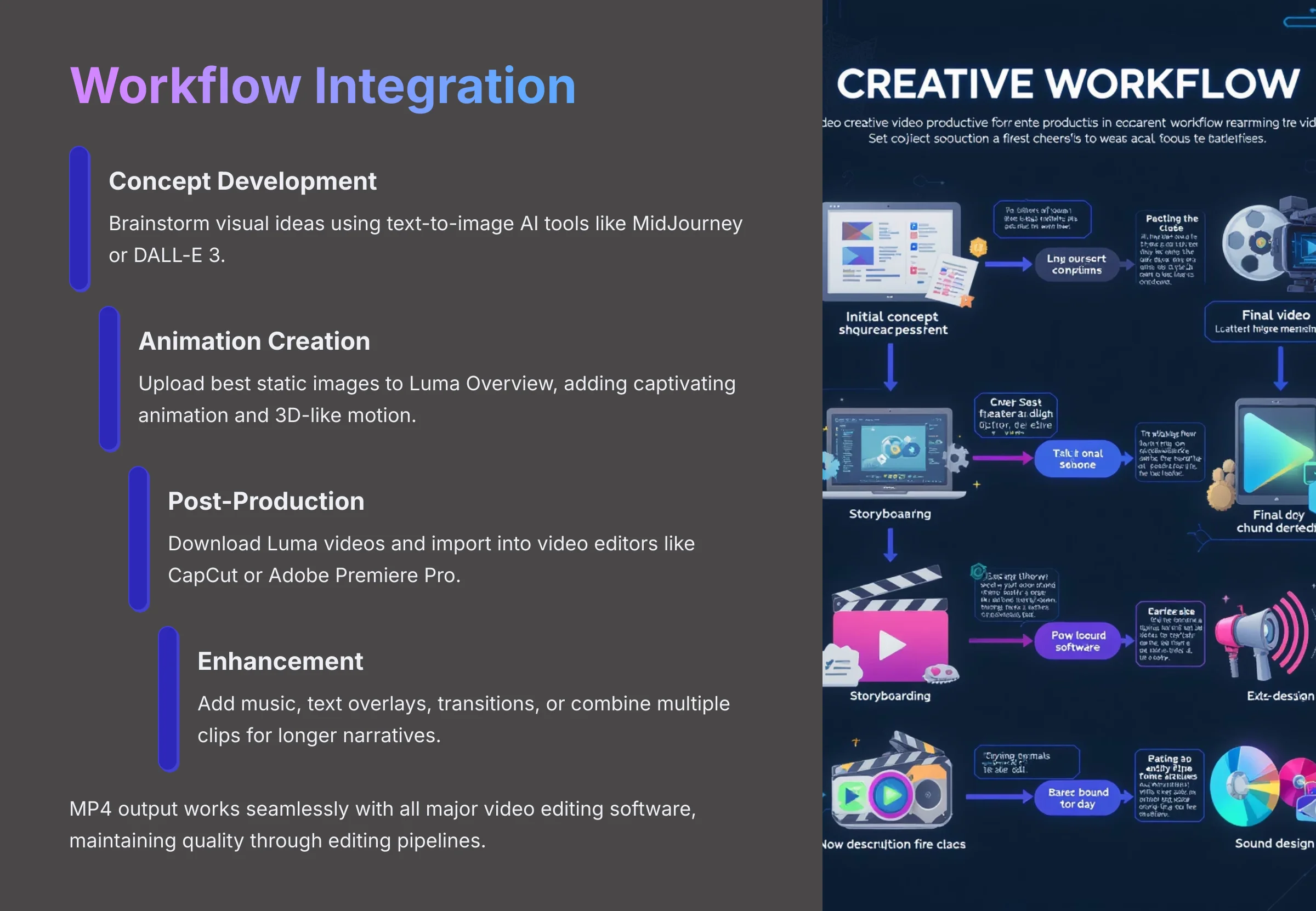

Luma Overview integrates smoothly into broader creative workflows, particularly excelling at animating AI-generated art and creating content for further editing in traditional video production software.
Typical Creative Workflow:
- Concept Development: Brainstorm visual ideas using text-to-image AI tools like MidJourney or DALL-E 3
- Animation Creation: Upload best static images to Luma Overview, adding captivating animation and 3D-like motion
- Post-Production: Download Luma videos and import into video editors like CapCut, Adobe Premiere Pro, or Final Cut Pro for final touches
- Enhancement: Add music, text overlays, transitions, or combine multiple clips for longer narratives
Integration Advantages:
- Format Compatibility: MP4 output works seamlessly with all major video editing software
- Quality Consistency: 720p output maintains quality through editing pipelines
- Creative Enhancement: Transforms static AI art into dynamic content for multimedia projects
File Management: Confirm image formats from other AI tools are compatible with Luma's accepted inputs. Most standard formats (JPEG, PNG) work effectively.
This combination creates powerful workflows for rapid visual prototyping, allowing creators to move from concept to finished video content efficiently.
Getting Started with Luma Overview: Your First Animated Video
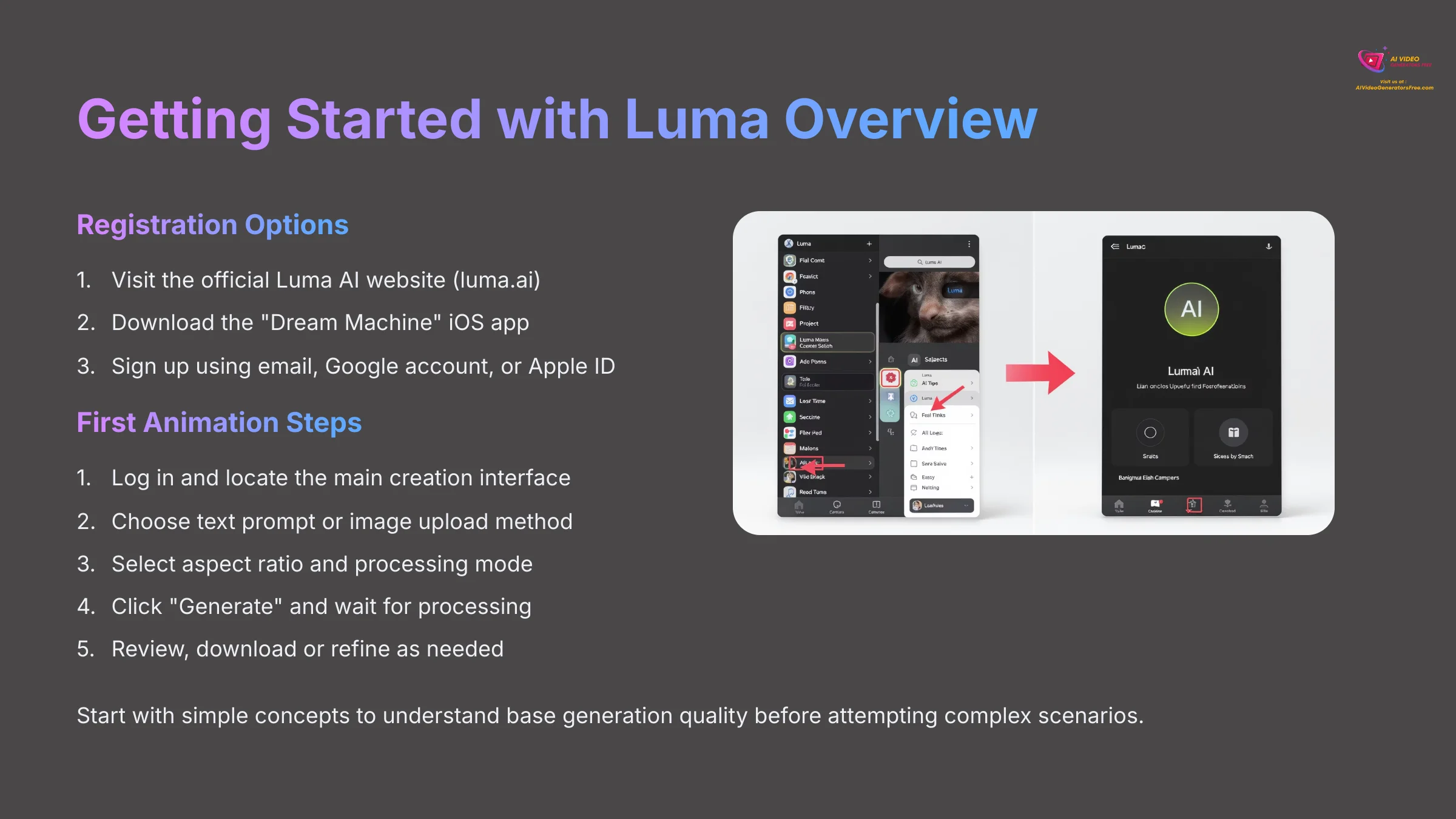

Quick Account Creation and Setup
Getting started with Luma Overview requires simple account setup:
Registration Options:
- Website Access: Visit the official Luma AI website (luma.ai) and locate the Dream Machine platform
- Mobile Access: Download the “Dream Machine” iOS app from the Apple App Store
- Account Creation: Sign up using email, Google account, or Apple ID
Security Best Practices:
- Use a password manager for secure account creation
- Check your email for verification links if required
- Verify you're on the official Luma AI website to avoid phishing attempts
Once logged in, you'll see an intuitive dashboard or creation interface designed for straightforward navigation and immediate video generation.
Step-by-Step: Generating Your First 3D-Like Animation
Creating your first animation with Luma Overview involves a streamlined process:
Step 1: Initial Setup
Log into your Luma account and locate the main creation interface.
Step 2: Choose Input Method
Select either text prompt entry (e.g., “A red ball bouncing with gentle camera follow”) or upload a clear, high-resolution image.
Step 3: Configure Settings
- Select aspect ratio (16:9 recommended for first attempts)
- Choose processing mode (Relaxed for experimentation, Fast if using credits strategically)
- Review any available animation parameters
Step 4: Generate Content
Click “Generate” and wait for processing, typically completing in under two minutes.
Step 5: Review and Refine
- Preview the generated video
- Download if satisfied, or modify prompts for iteration
- Use feedback to improve future generations
Beginner Recommendation: Start with simple concepts or Luma's example prompts if available. Try straightforward ideas like “red ball bouncing” to understand base generation quality and speed before attempting complex scenarios.
Learning Approach: Don't expect perfection on first attempts. AI video generation requires iterative refinement. Use initial results as learning experiences to understand the platform's capabilities and prompt requirements.
Exploring Luma's Learning Hub and Community
Luma AI provides comprehensive resources for skill development and community engagement:
Official Learning Resources:
- Learning Hub: Tutorials, guides, and FAQs for understanding capabilities
- Documentation: Technical specifications and best practices
- Example Gallery: Showcasing successful generations and prompt techniques
Community Support:
- Discord Community: Active user support, creation sharing, and technique discussions
- Showcase Channels: Inspiration from other users' creations and successful projects
- User Tips: Discovered techniques and unofficial optimization methods
Professional Development:
Our team at AI Video Generators Free frequently consults Luma's Discord for:
- Updates on unannounced features or improvements
- User-discovered optimization techniques
- Real-world application case studies
- Troubleshooting complex generation challenges
Support Channels: For official billing or account issues, use Luma's designated support channels rather than community forums. Community support excels for creative techniques and usage questions.
Supplemental Content
Luma Overview FAQ: Quick Answers
Is Luma Overview truly generating 3D models?
No, Luma Overview (Dream Machine) does not generate traditional, editable 3D models that you can use in software like Blender or Maya. It creates videos with sophisticated 3D-like effects including depth perception, parallax scrolling, and dynamic camera movements. These effects are achieved by animating 2D inputs using its AI model trained on video data, creating convincing illusions of three-dimensional space without actual 3D geometry.
What kind of “animation” can Luma create?
Luma can create several types of animation based on our testing:
- Animating static images to create “living photos” with natural movement
- Generating character actions and movements from text descriptions
- Creating dynamic camera movements including pans, tilts, zooms, rotations, and dolly shots
- Producing parallax effects that create strong depth perception
- Converting text prompts into complete animated scenes
- Transforming reference images into consistent animated sequences
How does Luma compare to other AI video tools in terms of 3D effects in 2025?
In our evaluation, Luma excels at generating highly realistic and cinematic motion from both images and text inputs. This often produces more convincing 3D-like depth and camera work compared to competitors focusing on simpler animations. Its direct video training approach gives Ray2 significant advantages in achieving fluid, natural motion. While not a full 3D creation suite, for creating convincing 2.5D animation and impressive depth effects from 2D sources, Luma represents a very strong option in 2025's AI video landscape.
Can I use videos from Luma Overview for commercial projects?
Yes, you can use videos from Luma Overview for commercial projects, but this depends on your subscription plan. You need an appropriate paid subscription (Plus, Unlimited, or Enterprise plans) for commercial usage rights. Free plans and lower-tier subscriptions typically restrict commercial use and include watermarks on output. Always verify the specific terms of your Luma AI plan before using generated content in commercial contexts.
Concluding Thoughts on Luma Overview's Place in AI Animation
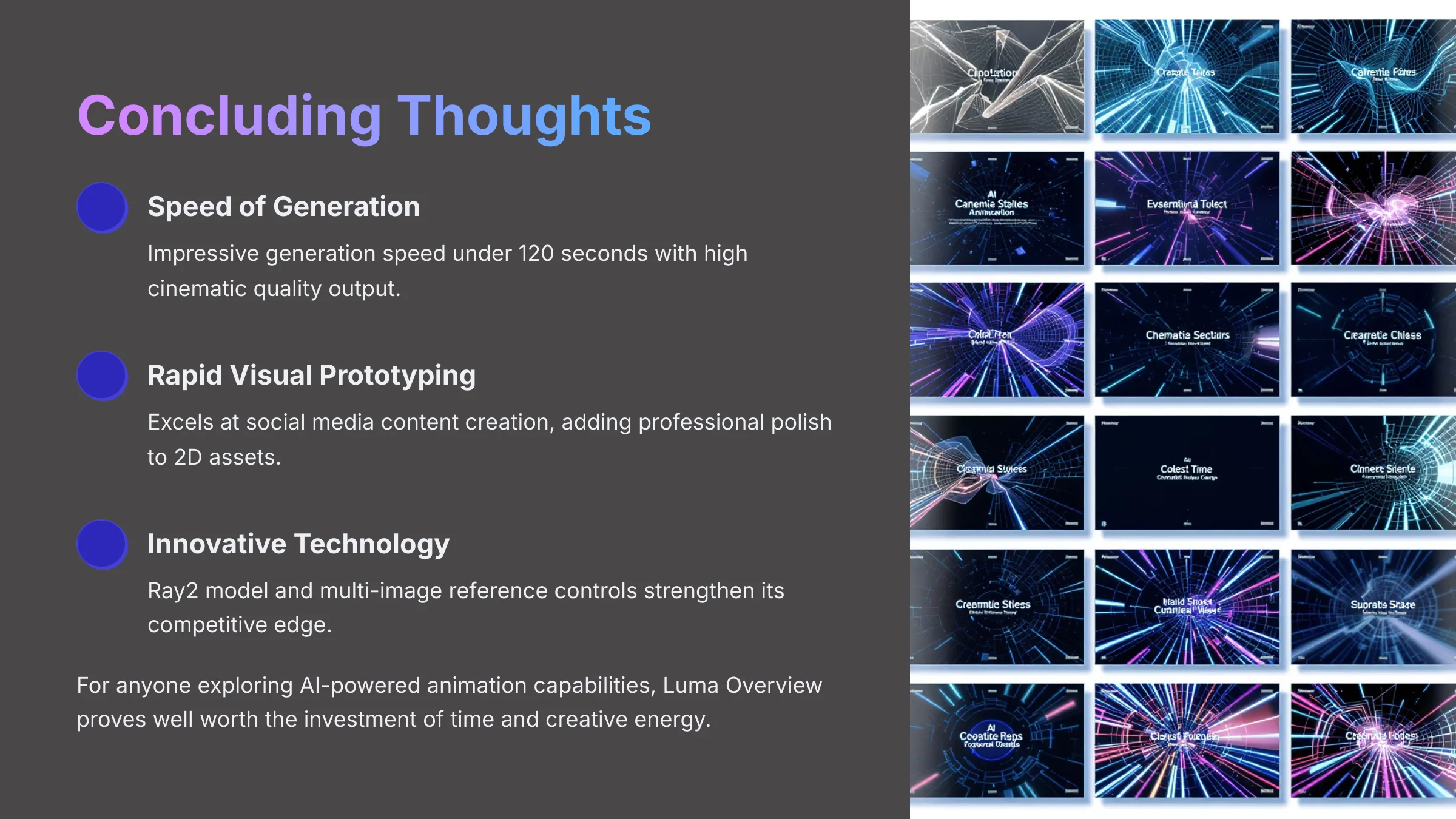

Rapid Prototyping and Cinematic Flair: Luma's Edge
Luma Overview has established a significant position in AI animation through impressive speed of generation (typically under 120 seconds) and high cinematic quality of output at 720p resolution. Its ease of use for creating dynamic, 3D-like animations from simple prompts or static images represents a major advantage for creators.
The platform excels at rapid visual prototyping and social media content creation, adding professional polish and convincing depth to 2D assets. The innovative Ray2 model and features like multi-image reference controls strengthen its competitive edge.
For anyone exploring AI-powered animation capabilities, investigating Luma Overview proves well worth the investment of time and creative energy.
Thank you very much for reading. Thank you for being here. And I wish you a delightful day!
Disclaimer
Disclaimer: The information about Luma Overview presented in this article reflects our thorough analysis as of 2025. Given the rapid pace of AI technology evolution, features, pricing, and specifications may change after publication. While we strive for accuracy, we recommend visiting the official Luma AI website for the most current information. Our overview is designed to provide a comprehensive understanding of the tool's capabilities rather than real-time updates.
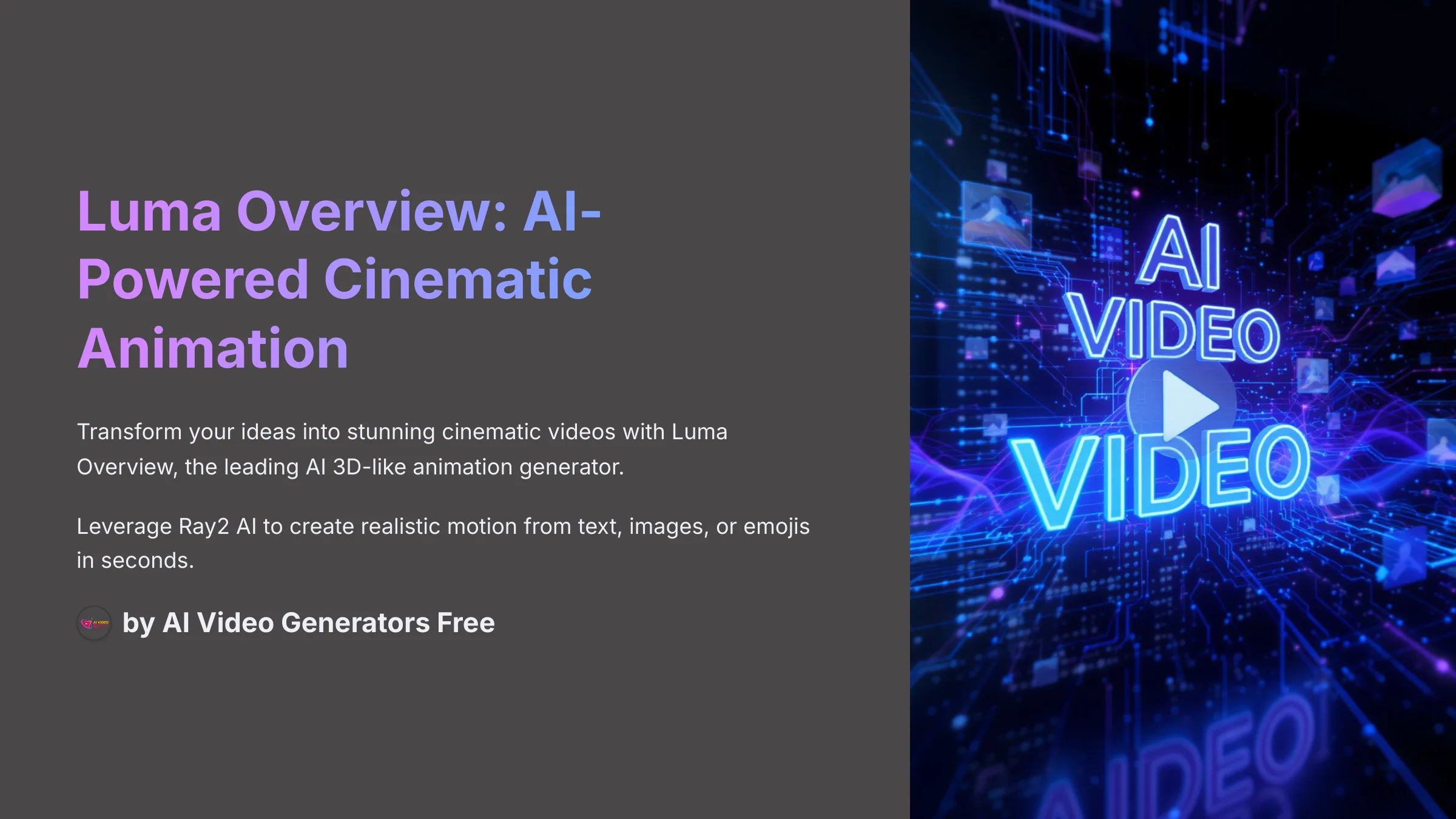

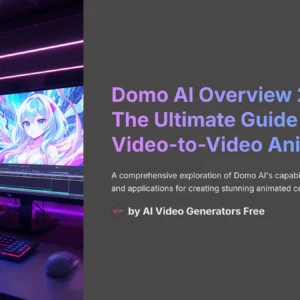
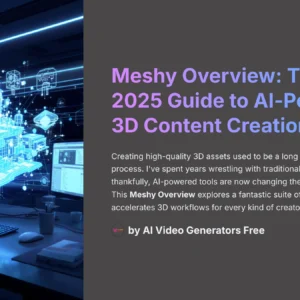
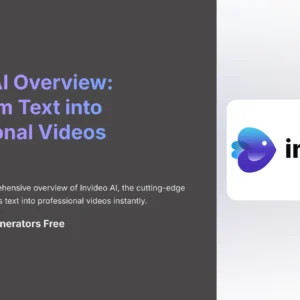



Reviews
There are no reviews yet.